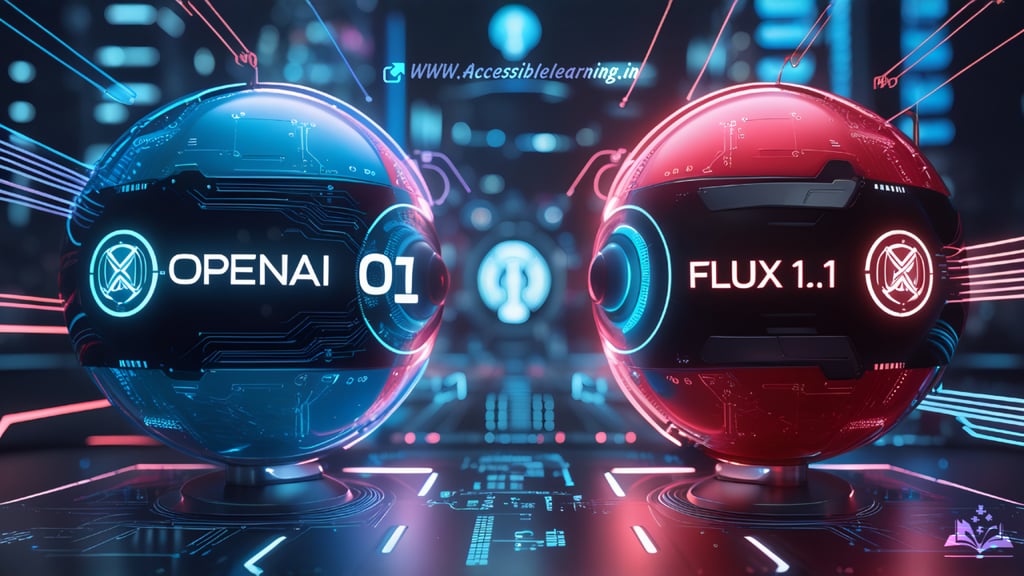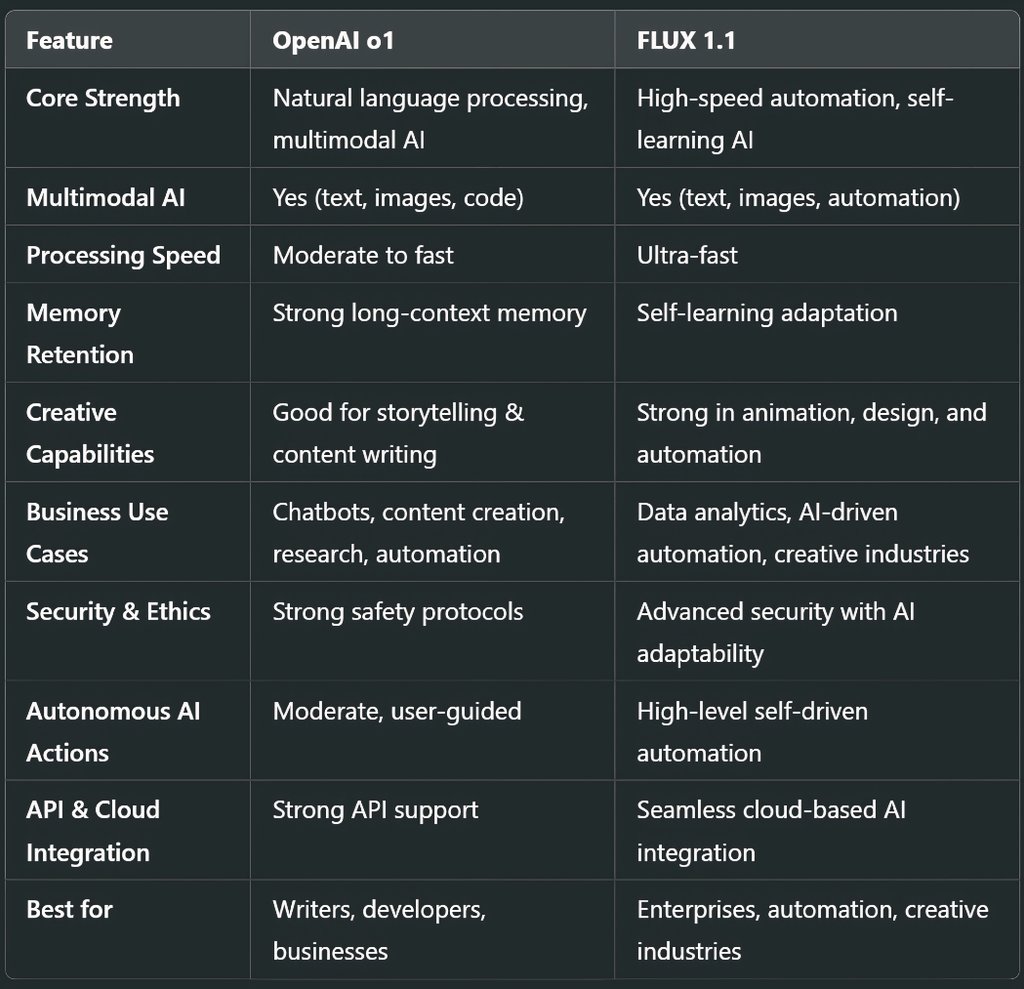
OpenAI o1 and FLUX 1.1: Strengths, Weaknesses, and Best Use Cases
OpenAI o1 vs FLUX 1.1—A detailed comparison of two cutting-edge AI models. Explore their features, capabilities, best-use cases, and which one suits your needs best.
AI/FUTUREEDITOR/TOOLSEDUCATION/KNOWLEDGEAI ART TOOLS
Sachin K Chaurasiya
3/29/20255 min read


Artificial intelligence is evolving at an unprecedented pace, and two of the most talked-about AI models today are OpenAI o1 and FLUX 1.1. Both are cutting-edge AI systems designed for various applications, including content generation, coding, creative design, and automation. But which one stands out? This article provides an in-depth comparison of OpenAI o1 and FLUX 1.1, analyzing their capabilities, strengths, and limitations.
What is OpenAI o1?
OpenAI o1 is the latest AI model from OpenAI, engineered to push the boundaries of natural language understanding, multimodal capabilities, and real-time decision-making. It builds on the success of GPT-4 and aims to integrate enhanced reasoning, faster processing, and better contextual awareness.
Key Features
Advanced Language Processing: OpenAI o1 boasts a deep understanding of language, making it highly effective for writing, translation, summarization, and dialogue-based AI applications.
Multimodal Capabilities: This model can process and generate text, images, and code, providing a seamless AI experience across different domains.
Improved Memory & Context Retention: OpenAI o1 enhances long-context understanding, making conversations and responses more coherent and contextually aware.
Real-time Adaptability: It learns from real-time inputs, enabling better personalization and adaptive content generation.
Security & Ethical AI Implementation: OpenAI o1 follows strict safety measures to reduce bias and ensure ethical AI use.
Enhanced Reasoning & Decision Making: OpenAI o1 is designed to handle complex queries with improved logical reasoning and problem-solving abilities.
Integration with Third-party APIs: This model supports seamless integration with various applications, making it highly functional for businesses and developers.
Strengths
Advanced Natural Language Processing (NLP)—OpenAI o1 excels in understanding and generating human-like text, making it highly effective for content creation, chatbots, and research-based applications.
Multimodal Capabilities—It can process text, images, and code, offering a versatile AI experience across different domains.
Strong Context Retention—OpenAI o1 can remember previous interactions well, ensuring long-form conversations and documents remain coherent.
Enhanced Reasoning & Decision-Making—It is designed to handle complex queries with improved logical reasoning and problem-solving abilities.
Security & Ethical AI—OpenAI o1 has built-in safety measures to minimize bias and ensure ethical AI usage.
Seamless API & Cloud Integration—It integrates smoothly with third-party applications, making it useful for businesses and developers.
Weaknesses
Slower Processing in Complex Tasks—While fast for general use, OpenAI o1 can slow down when dealing with highly intricate or large-scale tasks.
Overly Cautious AI—Due to strict ethical policies, it sometimes avoids answering controversial or complex queries that require nuance.
Limited Real-Time Adaptability—Unlike FLUX 1.1, it does not self-learn extensively from live interactions but relies on periodic updates.
Not Specialized for Automation—While it performs well in content-related tasks, it is not the best choice for high-speed automated workflows.


What is FLUX 1.1?
FLUX 1.1 is a powerful AI model developed to rival OpenAI’s technology, with a strong focus on creative automation, efficiency in data processing, and self-learning algorithms. It is widely used for high-speed content generation, AI-driven automation, and autonomous workflow optimization.
Key Features
Ultra-Fast Processing: FLUX 1.1 is optimized for rapid execution, making it ideal for businesses requiring high-speed content generation and automated workflows.
Neural Adaptability: This model leverages an advanced neural network structure that self-learns and improves over time, ensuring better results with prolonged usage.
Visual AI Integration: Unlike OpenAI o1, FLUX 1.1 heavily incorporates computer vision and augmented reality, making it more suitable for creative professionals in graphic design and animation.
Data-Driven Efficiency: FLUX 1.1 excels in data analysis, business intelligence, and trend forecasting, making it a top choice for enterprise applications.
Scalability & Cloud Integration: It seamlessly integrates with cloud-based infrastructures, providing AI-powered solutions at scale.
Autonomous AI Decision Making: FLUX 1.1 incorporates predictive analytics and AI automation, allowing businesses to streamline workflows and optimize decision-making processes.
Better AI Personalization: It is built to analyze user behavior and customize interactions based on individual preferences.
Strengths
Ultra-Fast Processing—FLUX 1.1 is optimized for speed, making it highly effective for businesses that require rapid AI execution.
Self-Learning & Adaptability—Unlike OpenAI o1, it continuously refines its responses based on real-time data and user interactions.
Strong Visual AI & Automation—FLUX 1.1 excels in creative industries, including design automation, augmented reality (AR), and video generation.
Enterprise-Level AI Scalability—It is designed for large-scale business operations, including AI-driven workflow automation and trend forecasting.
High-Level AI Autonomy—It can make independent decisions in automated environments, reducing human intervention.
Optimized for Business Intelligence—FLUX 1.1 processes large datasets efficiently, making it ideal for business analytics and decision-making.
Weaknesses
Weaker Language Understanding—While competent, FLUX 1.1 does not match OpenAI o1 in terms of nuanced language processing and deep contextual understanding.
Less Control Over AI Decisions—Since it is highly autonomous, users may find it challenging to fine-tune or correct its decisions.
Limited in Text-Based Applications—It performs well in automation and creative fields but may not be the best for writing-intensive tasks like storytelling.
Security & Ethical Concerns—While improving, its AI ethics framework is not as rigorous as OpenAI o1’s, which could lead to occasional biases.


Which AI Model is Better?
When to Choose OpenAI o1:
If you need advanced natural language processing for content writing, chatbots, or research.
If you require multimodal AI that can handle both text and images.
If long-term memory retention and contextual awareness are important.
If ethical AI implementation and safety measures are a priority.
If you're looking for an AI assistant that can reason through complex problems effectively.
When to Choose FLUX 1.1:
If you require high-speed automation and data-driven efficiency.
If your work involves visual AI, design automation, or AR applications.
If you need an AI model that self-learns and improves with usage.
If cloud-based scalability and enterprise-level AI solutions are crucial.
If you're in the business intelligence or creative automation sector and need a more adaptable AI solution.
Future of AI: What’s Next?
With rapid advancements in AI technology, we can expect next-gen AI models to include even more sophisticated capabilities, such as:
Enhanced multimodal AI with better real-world applications.
Self-improving algorithms that evolve autonomously over time.
More ethical and responsible AI frameworks to prevent misinformation.
Better AI-human collaboration tools for businesses and creatives.
Both OpenAI o1 and FLUX 1.1 are revolutionary AI models, but their applications differ significantly. OpenAI o1 excels in language processing, multimodal interactions, and real-time adaptability, while FLUX 1.1 dominates in speed, automation, and creative AI applications. The right choice depends on your specific needs, industry, and AI expectations.
As AI continues to advance, both models are likely to evolve with new capabilities, making the competition even more exciting. Whether you are a writer, developer, or business professional, choosing between OpenAI o1 and FLUX 1.1 depends on how you plan to leverage AI in your workflow.
What’s Your Take?
Do you prefer the precision of OpenAI o1 or the speed and adaptability of FLUX 1.1? Let us know in the comments below! If you found this comparison useful, don’t forget to share it with fellow AI enthusiasts.
Subscribe To Our Newsletter
All © Copyright reserved by Accessible-Learning Hub
| Terms & Conditions
Knowledge is power. Learn with Us. 📚


